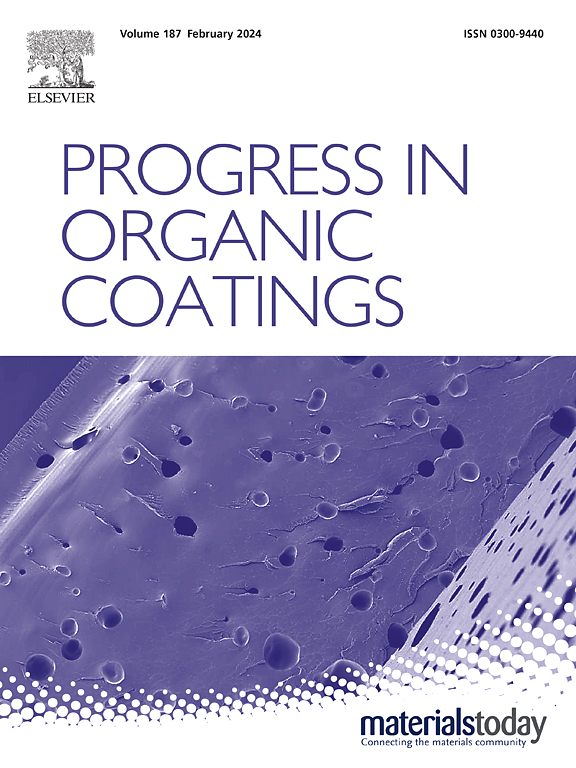具有优异防腐性能的超疏水环氧/PANI@CNTs涂层的制备
IF 7.3
2区 材料科学
Q1 CHEMISTRY, APPLIED
引用次数: 0
摘要
超疏水涂层表面结构稳定性差、界面相容性差、附着力差,限制了超疏水涂层在防腐领域的应用。本文采用有机-无机杂化和化学改性相结合的方法制备了具有优异机械化学稳定性的环氧/PANI@CNTs复合超疏水涂层。通过原位聚合苯胺在碳纳米管表面合成PANI@CNTs纳米填料,构建超疏水性所需的纳米微观结构,增强其缓蚀能力。最佳涂层的高接触角为159.5±0.8°,低滑动角为3±0.4°。由于聚苯胺、硅羟基与基体表面形成氢键,涂层的附着力达到最高等级(GB/T9286)。在480 s的水冲击、1000 g落砂冲击和500次磨损循环后,涂层仍保持超疏水性,这可归因于有机-无机杂化和氢键相互作用产生的多界面增强。此外,制备的涂层还具有出色的耐蚀性,在浸泡15天后,其低频阻抗模量保持在4.79 × 108 Ω·cm2,约为不含PANI@CNTs的超疏水涂层的3倍。这主要是由于气膜屏蔽、涂层的物理屏蔽和聚苯胺的协同钝化形成的三重保护机制,使其具有优异的防腐性能。因此,本研究有望为超疏水涂层在金属机械设备防腐中的应用提供理论参考。本文章由计算机程序翻译,如有差异,请以英文原文为准。

Fabrication of robust superhydrophobic epoxy/PANI@CNTs coatings with excellent anti-corrosion property
The application of superhydrophobic coatings in the corrosion protection field is limited by their poor surface structural stability, interfacial compatibility and adhesion strength. Herein, we prepared an epoxy/PANI@CNTs composite superhydrophobic coating with excellent mechanochemical stability by the combination of organic-inorganic hybridization and chemical modification. PANI@CNTs nanofillers synthesized by in-situ polymerization of aniline on the CNTs surface were used to construct the necessary nano-microstructures for superhydrophobicity and enhance the corrosion inhibition. The optimal coating showed high water contact angle of 159.5 ± 0.8° and low sliding angle of 3 ± 0.4°. The adhesion strength of the prepared coating attained the highest grade (GB/T9286) due to the formation of hydrogen bonds among polyaniline, silicon hydroxyl groups and the substrate surface. Moreover, the prepared coating maintained its superhydrophobicity even after 480 s of water impact, 1000 g falling sand impact or 500 abrasion cycles, which can be ascribed to the multi-interface enhancement generated by the organic-inorganic hybridization and the hydrogen bonds interaction. Furthermore, the prepared coating also possessed outstanding corrosion resistance with low-frequency impedance modulus remained at 4.79 × 108 Ω·cm2 after immersion for 15 days, which was approximately three times that of the superhydrophobic coating without PANI@CNTs. This is mainly due to the triple protection mechanism formed by the air-film shielding, physical shielding of the coating and the synergistic passivation of polyaniline, endowing it with excellent anti-corrosion performance. Therefore, this study is expected to provide a theoretical reference for the application of superhydrophobic coatings in the corrosion protection of metal mechanical equipment.
求助全文
通过发布文献求助,成功后即可免费获取论文全文。
去求助
来源期刊

Progress in Organic Coatings
工程技术-材料科学:膜
CiteScore
11.40
自引率
15.20%
发文量
577
审稿时长
48 days
期刊介绍:
The aim of this international journal is to analyse and publicise the progress and current state of knowledge in the field of organic coatings and related materials. The Editors and the Editorial Board members will solicit both review and research papers from academic and industrial scientists who are actively engaged in research and development or, in the case of review papers, have extensive experience in the subject to be reviewed. Unsolicited manuscripts will be accepted if they meet the journal''s requirements. The journal publishes papers dealing with such subjects as:
• Chemical, physical and technological properties of organic coatings and related materials
• Problems and methods of preparation, manufacture and application of these materials
• Performance, testing and analysis.
 求助内容:
求助内容: 应助结果提醒方式:
应助结果提醒方式:


